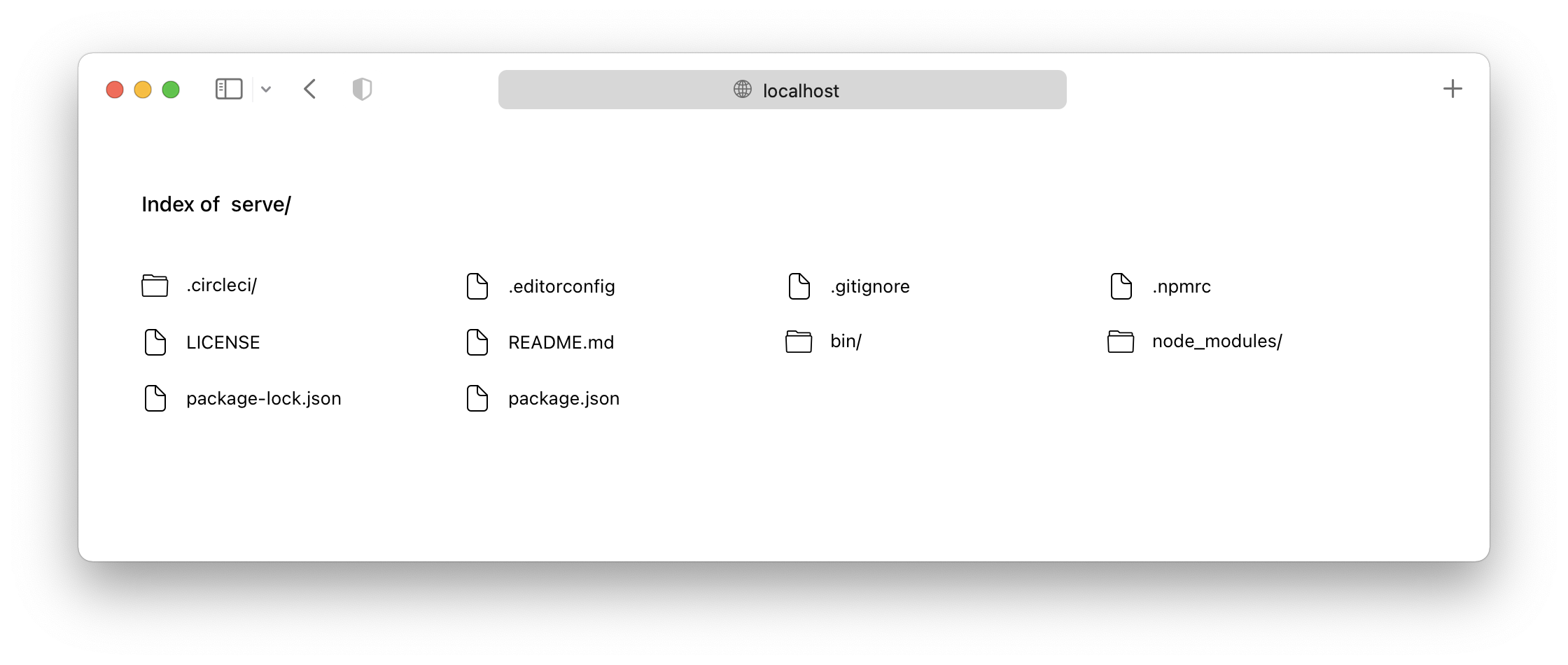97 lines
3.2 KiB
Markdown
97 lines
3.2 KiB
Markdown
|
|

|
||
|
|
|
||
|
|
<div align="center">
|
||
|
|
<a aria-label="Vercel logo" href="https://vercel.com">
|
||
|
|
<img src="https://img.shields.io/badge/made%20by-vercel-%23000000">
|
||
|
|
</a>
|
||
|
|
<br>
|
||
|
|
<a aria-label="Install Size" href="https://packagephobia.com/result?p=serve">
|
||
|
|
<img src="https://packagephobia.com/badge?p=serve">
|
||
|
|
</a>
|
||
|
|
<a aria-label="Stars" href="https://github.com/vercel/serve/stargazers">
|
||
|
|
<img src="https://img.shields.io/github/stars/vercel/serve">
|
||
|
|
</a>
|
||
|
|
<a aria-label="Build Status" href="https://github.com/vercel/serve/actions/workflows/ci.yaml">
|
||
|
|
<img src="https://github.com/vercel/serve/actions/workflows/ci.yaml/badge.svg">
|
||
|
|
</a>
|
||
|
|
</div>
|
||
|
|
|
||
|
|
---
|
||
|
|
|
||
|
|
`serve` helps you serve a static site, single page application or just a static file (no matter if on your device or on the local network). It also provides a neat interface for listing the directory's contents:
|
||
|
|
|
||
|
|

|
||
|
|
|
||
|
|
> Once it's time to push your site to production, we recommend using [Vercel](https://vercel.com).
|
||
|
|
|
||
|
|
## Usage
|
||
|
|
|
||
|
|
> `serve` v14 onwards requires Node v14 to run. Please use `serve` v13 if you cannot upgrade to Node v14.
|
||
|
|
|
||
|
|
The quickest way to get started is to just run `npx serve` in your project's directory.
|
||
|
|
|
||
|
|
If you prefer, you can also install the package globally (you'll need at least [Node LTS](https://github.com/nodejs/Release#release-schedule)):
|
||
|
|
|
||
|
|
```bash
|
||
|
|
> npm install --global serve
|
||
|
|
```
|
||
|
|
|
||
|
|
Once that's done, you can run this command inside your project's directory...
|
||
|
|
|
||
|
|
```bash
|
||
|
|
> serve
|
||
|
|
```
|
||
|
|
|
||
|
|
...or specify which folder you want to serve:
|
||
|
|
|
||
|
|
```bash
|
||
|
|
> serve folder-name/
|
||
|
|
```
|
||
|
|
|
||
|
|
Finally, run this command to see a list of all available options:
|
||
|
|
|
||
|
|
```bash
|
||
|
|
> serve --help
|
||
|
|
```
|
||
|
|
|
||
|
|
Now you understand how the package works! :tada:
|
||
|
|
|
||
|
|
## Configuration
|
||
|
|
|
||
|
|
To customize `serve`'s behavior, create a `serve.json` file in the public folder and insert any of [these properties](https://github.com/vercel/serve-handler#options).
|
||
|
|
|
||
|
|
## API
|
||
|
|
|
||
|
|
The core of `serve` is [`serve-handler`](https://github.com/vercel/serve-handler), which can be used as middleware in existing HTTP servers:
|
||
|
|
|
||
|
|
```js
|
||
|
|
const handler = require('serve-handler');
|
||
|
|
const http = require('http');
|
||
|
|
|
||
|
|
const server = http.createServer((request, response) => {
|
||
|
|
// You pass two more arguments for config and middleware
|
||
|
|
// More details here: https://github.com/vercel/serve-handler#options
|
||
|
|
return handler(request, response);
|
||
|
|
});
|
||
|
|
|
||
|
|
server.listen(3000, () => {
|
||
|
|
console.log('Running at http://localhost:3000');
|
||
|
|
});
|
||
|
|
```
|
||
|
|
|
||
|
|
> You can also replace `http.createServer` with [`micro`](https://github.com/vercel/micro).
|
||
|
|
|
||
|
|
## Issues and Contributing
|
||
|
|
|
||
|
|
If you want a feature to be added, or wish to report a bug, please open an issue [here](https://github.com/vercel/serve/issues/new).
|
||
|
|
|
||
|
|
If you wish to contribute to the project, please read the [contributing guide](contributing.md) first.
|
||
|
|
|
||
|
|
## Credits
|
||
|
|
|
||
|
|
This project used to be called `list` and `micro-list`. But thanks to [TJ Holowaychuk](https://github.com/tj) handing us the new name, it's now called `serve` (which is much more definite).
|
||
|
|
|
||
|
|
## Author
|
||
|
|
|
||
|
|
Leo Lamprecht ([@notquiteleo](https://twitter.com/notquiteleo))
|